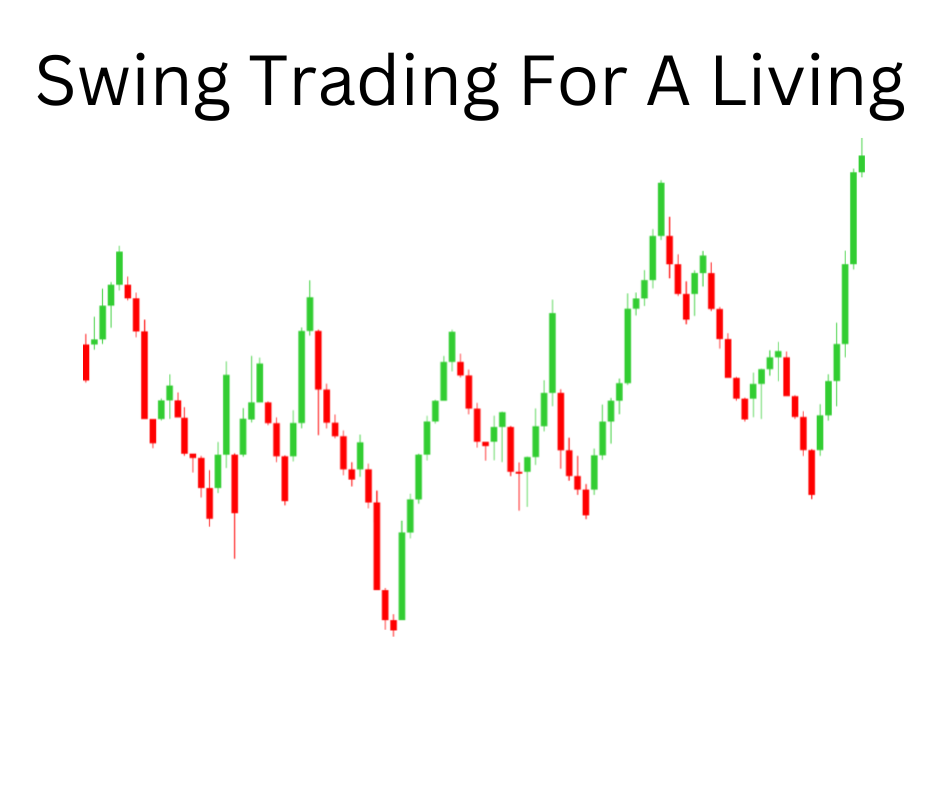Swing trading is a popular form of Forex trading that involves taking positions that last for a few days to a few weeks, capitalizing on large market movements.
But can you swing trade for a living? In this post, we’ll look at the pros and cons of swing trading and see how you can make a living doing so.
The most difficult part of swing trading for a living is not making enough money, it’s something else, and we’ll get to that too!

How much money can you make swing trading?
The amount of money you can make through swing trading really depends on the amount of capital you have and the amount of money you need to cover your living expenses.
For example, if you have a $100,000 funded account and you take 2-4 trades every month with 1:3 risk-to-reward ratios, it’s fairly reasonable to expect making $6,000 to $12,000 per month, assuming you have a decent win rate.
This number can increase or decrease depending on your trading capital and your swing trading strategy.
The Forex market is an unpredictable beast and you’ll have months with multiple lose trades and months with multiple winning trades, so some months will invariably be better than others.
Because of this, it’s not ideal to depend on trading as your only source of income, since you can have a bad month or even a string of bad months.
Compounding your account
Trading – whether it’s day trading, swing trading, or position trading – is a patient person’s game, so you have to be in it for the long run.
If you don’t have a funded trading account and you don’t have enough capital to start, you’ll need to slowly compound your account.
The time it takes to compound to a decent amount of money will depend on how much capital you started with and how much you make every month. There are compounding calculators that you can use to play around with the numbers.
One under-utilized compounding strategy is to actually add money to your account at the end of every profitable month.
You can only do this if you have an additional monthly income, of course.
Adding money to your account increases your rate of compounding significantly.
For example, if you have $1,000 in your account and you make 10% every month, you’ll make $100 in the first month, then $110 in the second month, and so on.
But if you add $1,000 to your account at the end of every profitable month, your compounding gets even faster.
The real challenges of swing trading for a living
Watching your profits swing up and down
Swing trading strategies involve holding positions for days or even weeks, patiently waiting as the market swings from one area to the next.
In between these swings, there can be wildly volatile movements, meaning you can be in profit one morning, in a loss the next morning, and in profit again the next.
You need to be extremely patient and have nerves of steel to watch your gains and losses go up and down, and really have trust in your trading strategy.
Otherwise, fear and greed can get the best of you and you end up closing profitable trades too early, or even worse, closing profitable trades for a loss.
Finding something to do with your free time
Since swing trading involves holding positions for a long time, most traders end up losing money because their fingers get itchy and start taking too many trades.
The Forex market hours are 24/5, so you could potentially stare at the charts all day long. There’s nothing worse for your trading than staring at the charts for too long, so you could lose money really quickly if you start developing itche fingers.
If you’re swing trading, you’ll need to have the patience of a saint and the self control of a monk!
That’s the only way you’ll be able to generate consistent profits through swing trades.
If you swing trade on the side or have plenty of other things to do during the day, you can keep yourself busy enough to not stare at charts all day long.
How much time do you need to swing trade for a living?
Swing traders can trade for a living by just spending 1-3 hours a day looking at charts. In fact, any more time and you’ll increase your chances of losing trades!
When you start swing trading, you won’t look at timeframes smaller than the four hour or one hour chart.
That means the charts will only show new information every hour or every four hours(depending on your strategy), so you only need to check the charts every so often.
There will also be times where you’re waiting for the market to reach a certain price, so unless and until the market conditions match what you’re looking for, there won’t be much to do!
1-3 hours is really all most swing traders need for both placing trades and trade management.
You should only manage your trades every time a new candle prints, anyway.
You can and should have another source of income
The best financial advice you’ll ever receive in life is that you should have multiple sources of income. If you rely on a single source of income, you’ll be in a tough situation if that source of income dries up.
Even a single bad month can put you in a dire situation.
In trading, it’s very possible to have bad months.
A low-degree bad month could mean a month where you broke even or didn’t quite hit your profit target to maintain your lifestyle.
A very bad month could mean when you lost a sizeable chunk of your capital.
Having another source of income will help prevent you from taking rash decisions in your trading.
The easiest way to lose money in the Forex market is to take irrational trades based on emotion. If money is tight, emotions will kick in and you’ll start to take losing trades. As you lose trades, you’ll want to make that money back, which means you’ll take revenge trades, and that never ends well.
Even if you don’t have a second source of income at this point in time, you need to start thinking about how to generate one TODAY.
Start putting some of your profits into safer, more stable investments and let those investments compound as well.
For me, an ideal portfolio is a good mix of trading income and real estate.
There are no safety nets
As a swing trader, you’ll need to understand that there are no safety nets. If you don’t trade, you don’t make money. And if you trade poorly, you’ll actually lose money.
If you fall sick or are not in the right state of mind to trade, your income will dry up.
Compare this to a owning a business where you can outsource or delegate your work to at least keep the business running.
In trading, there’s no outsourcing or delegation: it all depends on you and you alone.
Bad days means lost money
Trading is one of those professions where mistakes are VERY costly.
In a traditional business, there’s usually some scope to recover money from a bad business deal.
In trading, a bad trade means you immediately lose the money that you risked.
In a regular business, you’ll only have to bear your running expenses even if you don’t get any customers. This would be considered a slow day.
In trading, a day you don’t take any trades is considered a good day, because you didn’t lose any money!
It’s important to realize that every time you expose yourself to the market, your chances of losing money are actually greater than your chances of making money.
Conclusion
You can become a professional trader and swing trade for a living if you utilize good risk management strategies and are patient.
If you’re looking to trade for a living, the most important skill you can work on to improve trading performance is to develop patience.
This is where most aspiring traders lose money, and it’s why swing trading is not for everyone.
